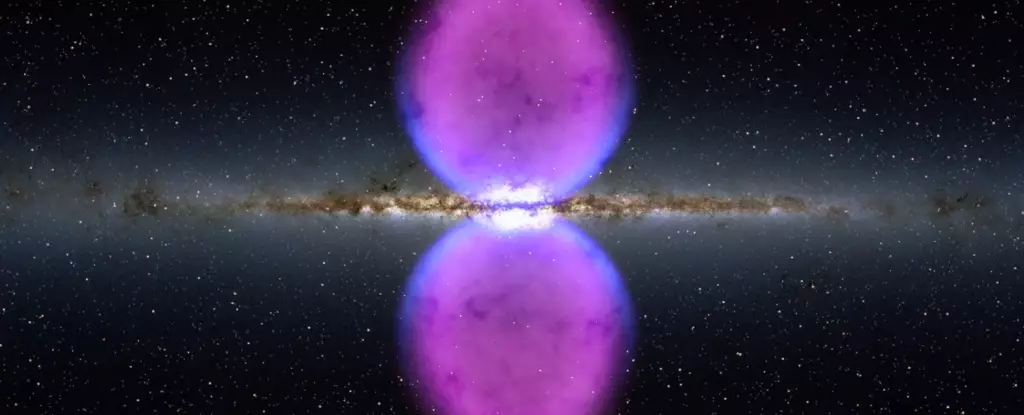In the vast, turbulent environment surrounding our Milky Way, astronomers have long considered the presence of cold gas to be an anomaly rather than a norm. The recent discovery of 11 surprisingly frigid hydrogen clouds deep within the Fermi Bubbles—the colossal, energetic outflows extending tens of thousands of light-years from the galactic center—shatters previous assumptions. Typically, such intense cosmic structures are associated with blisteringly hot plasma and dynamic chaos, making these cold clouds look like abominable surprises in a seething brew of energy. This revelation compels us to reconsider the resilience of cold matter in some of the universe’s most hostile environments.
The Fermi Bubbles, detected in 2010 through gamma-ray observations, have long fascinated scientists. These enormous lobes of high-energy particles and plasma are thought to be the aftermath of past outbursts from the supermassive black hole at the galaxy’s core—events that launched energetic winds and gas flows into the halo, shaping the galaxy’s evolution. For decades, the narrative painted these bubbles as purely scorching domains, where temperatures soared to millions of degrees Celsius, rendering the survival of cold clouds nearly impossible. The presence of these cold hydrogen pockets, therefore, is nothing short of a cosmic paradox that necessitates a reevaluation of our models.
Revolutionary Observations and Their Implications
Utilizing the unparalleled sensitivity of the Green Bank Telescope—a facility known for peering deeper into cosmic mysteries—researchers identified hydrogen clouds that defy expectations. These clouds are not only significantly cooler than their surroundings but also structurally complex, with sizes up to 91 light-years and masses reaching a thousand solar masses. Perhaps most astonishing is their high latitude positioning, with some residing 13,000 light-years above the galactic center—an unlikely locale for such cold entities given the energetic turbulence.
What makes these findings groundbreaking isn’t just their existence but their implications for galactic physics. The fact that these clouds are estimated to be only a few million years old aligns with the observed age of the Fermi Bubbles but contradicts older formation models that predicted different timescales. If these clouds are remnants or fragments carried aloft by the nuclear wind—a high-velocity outflow from the galactic core—then it suggests that cold gas can survive or form anew amidst violent, energetic flows. Such resilience hints at mechanisms of thermal stability or rapid cooling that were previously underestimated. These processes could include thermal instabilities within the plasma, allowing pockets of cooler gas to condense from hotter surroundings, or perhaps the clouds originated elsewhere and were subsequently entrained by the outflows.
This discovery also adds a new layer of complexity to our understanding of the galactic lifecycle. The cycling of matter—where gas is expelled, cools, and eventually recycles back into star-forming regions—is fundamental to galaxy evolution. Finding cold hydrogen clouds amid superheated plasma indicates that the galactic ecosystem operates with remarkable intricacy, with phases of cooling and heating intersecting in ways previously thought impossible.
Reassessing Galactic Evolution and Future Perspectives
This breakthrough extends beyond merely revising models of the Milky Way. It signals that the universe’s grand narrative of galaxy formation and evolution is far more nuanced. The presence of cold gas in extreme environments implies that galactic winds are not uniformly destructive; they can, under certain conditions, harbor and preserve colder matter, potentially facilitating new star formation far from the galactic disk.
Furthermore, these observations challenge astrophysicists to refine their theories about the lifecycle of gas within galaxies. If cold hydrogen clouds can withstand the torrid conditions associated with energetic outflows, then the processes of thermal instability, magnetic field influence, and cloud fragmentation merit heightened attention. This could reshape how we interpret the role of galactic feedback—where energy emitted by black holes, supernovae, and star formation regulate galaxy growth.
As we deepen our understanding through future high-sensitivity surveys, these cold clouds could become a key observational touchstone for developing more accurate models of galaxy evolution across the universe. Their existence hints that even amid chaos, regions of tranquility persist—reminding us that cosmic environments are often more resilient and adaptable than our current theories suggest.
In the grand cosmic story, the discovery of these icy entities within the fiery heart of the Milky Way’s halo is a compelling testament to the universe’s ability to surprise and redefine our understanding of fundamental astrophysical processes. It challenges us to view galactic turbulence not merely as destructive chaos but as a catalyst for complexity, resilience, and perhaps even renewal.

